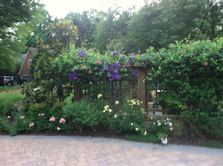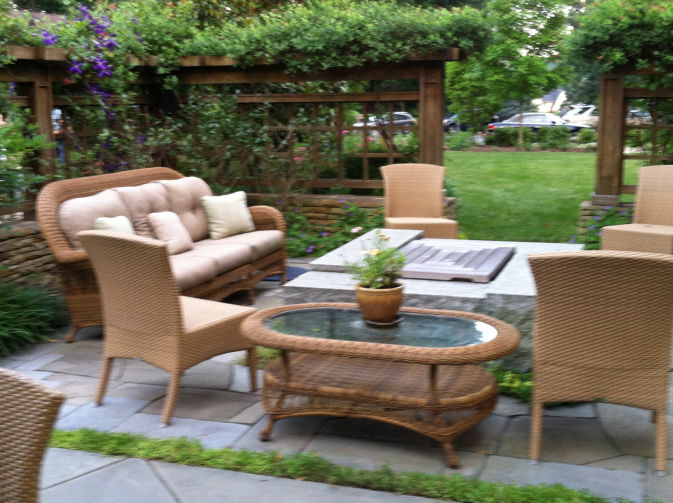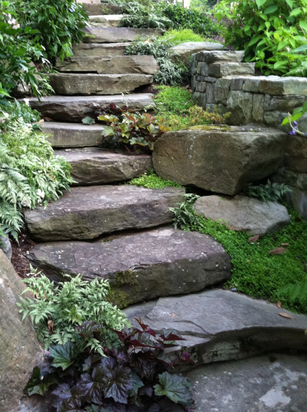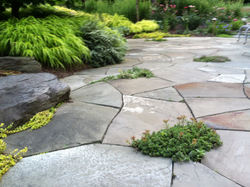|
by Lynn M. Koch
This spring I had the good fortune to hear Karen Rexrode give a presentation entitled “Perennials with Personality’. If you are not familiar with Karen, she is the former owner and founder of Windy Hill Plant Farm, perennial specialist, and photographer, as well as a great speaker. She is now an estate gardener at Oak Hill. For this talk, she borrowed off ideas presented in “Planting Design – Gardens in Space and Time’ by Piet Oudolf and Noel Kingsbury (pub. 2005). The theme was that there are basically 4 types of growth strategies for plants designed for their survival, although they do not always stay within one group. While we like to ‘judge’ plants for their beauty, plant growth is actually about their survival. Karen discussed 4 categories plants have that she uses to place her plants in the landscape. She admitted that the areas are very gray, and there is often crossover, but the important thing is habitat. This seems basic, but it’s a good refresher when we try to think about seasons, layers and massings (i.e., once it’s over, what’s next?) Stress Tolerators:
Personality: Independent, determined These plants bloom early so pollination is assured, and are often deer resistant. Stress Avoiders:
Personality: Practical, idealistic One of the better combinations to plant are these with plant ‘Competitors’, such as Primula sieboldii under hosta and ferns. Ruderal or Pioneers:
Personality: Risk takers, live for the moment True annuals belong in this category. Deer and rabbits tend to munch them, and they often seed in various locations due to wind. They don’t need much to germinate (no mulch!) and ‘wait for the light’. i.e., even after many years, seeds hidden in areas come to life after exposure. Over the long term, these plants might get messy and need more time to manage them. Competitors:
Personality: Assertive, outspoken These plants are easy in that they help keep out weeds, extend sideways via rhizominus roots and can be easily ‘whacked’ back. These can be cut back in June and July to keep them from falling over. Solomon seal with Japanese painted fern are both competitors, but great in massing. Keep these plants in control by pulling out ‘extras’ and giving them to friends (or your compost pile). Their lines need to be managed. So next time you are designing with perennials, think about their ‘personality traits’ before you put combinations together. The end result will provide seasonal beauty and happy plants!
1 Comment
 Submitted by Susanna Membrino, Dawn Szelc, and Mary Rollefson The Landscape Designer Group met in the evening of June 16 at a private garden in Bethesda designed by Paul Davis, of H. Paul Davis Landscape Architects. Paul is a long-time LDG member and has worked for the last 17 years to change American University’s 84 acre campus into an extensive arboretum. In all of his gardens, Paul works in collaboration with nature to structure designs and gardens that create a sense of space and beauty. After refreshments, provided by the Hospitality Committee, Paul led us on a tour of the large garden built over many years in three phases. Paul began by describing the initial project which was to create an outdoor entertaining space in the front of the house. The entrance to the house is south-facing and the client originally asked for a patio at the entrance that would work as a place for the family to eat outdoors and entertain. Starting with an original cherry tree, Paul built a patio at its base and created a sense of seclusion by trans-planting shrubs and perennials from other parts of the property and building a screen, now covered by honeysuckle creating a clearly defined entrance.
Phase 3 began with acquisition of the house and property on the opposite side of the home. As with phase 2, this home was dismantled by an architectural salvage firm, Second Chance, including removal of a tennis court. Above the garden, the lawn steps up through three tiers to a spacious patio. The garden consists of a large swath of perennials and a potager garden of multiple raised stone beds, concentric, set into a gravel base, and surrounded by fruit trees and berry bushes. The stone work was done by Santos. Additional beds at ground level, contain bamboo frames for climbing vegetables. Raspberries, strawberries, and blackberries grow below the circle. The garden contains the familiar vegetables and lettuces, a cutting garden, and herbs. A small potting shed stands to one side. It takes little imagination to picture the garden in August in full production and we are wondering if there will be any extra tomatoes for the group.
The LDG website has been redone and improved! We hope you like it. Please send your feedback to the webmaster if you have any thoughts or proposed changes.
After many years of using a desktop software program to create and manage the LDG website, I have now found a web-based program to help easily manage all of its parts! What's even better? You can contribute as you'd like, especially on this blog. All you have to do is send me a note and I'll give you permissions to add whatever you like on the website, just by having a simple username and password. One great new improvement is the ability to RSVP to program meetings directly on the website, without having to send a separate email! So, send a note to [email protected] and get started putting your own thoughts, ideas, and contributions to the blog and website. Remember, it takes a village! Best, Holly Radus LDG Webmaster |
AuthorsLDG is a non-profit corporation dedicated to the exchange and enhancement of knowledge relevant to the landscape design profession. We are a group of professional designers in the metropolitan Washington, DC area. Membership is meant for students studying and professionals employed in landscape design or associated professions (i.e. arborists, installers, contractors, etc.). Archives
October 2023
CategoriesPast Newsletters can be found in the Members Only Section of the LDG Membership Connection. You must sign in to view these files.
Past Newsletters |
|
Search for a Landscape Designer in Your Area:
|



 RSS Feed
RSS Feed
